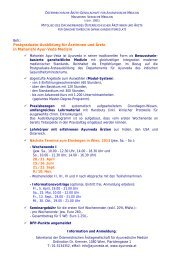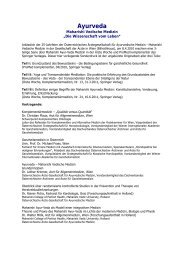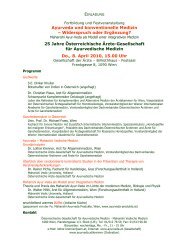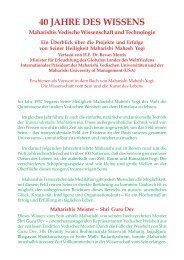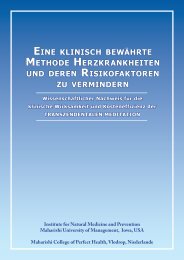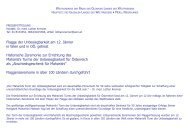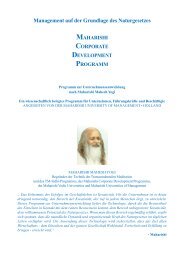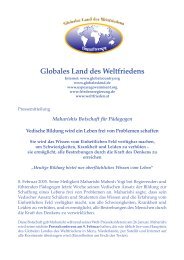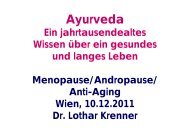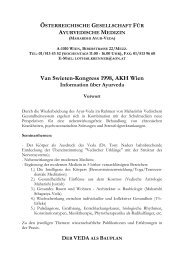Summary of Research Findings
Summary of Research Findings
Summary of Research Findings
You also want an ePaper? Increase the reach of your titles
YUMPU automatically turns print PDFs into web optimized ePapers that Google loves.
<strong>Research</strong> on the Transcendental Meditation ® Program (continued)<br />
4. Title<br />
The Impact <strong>of</strong> the Transcendental Meditation Program on Government Payments to<br />
Physicians in Quebec: An Update<br />
Publication<br />
American Journal <strong>of</strong> Health Promotion, Vol. 14, No. 5, pp. 284-291, 2000.<br />
Authors<br />
Robert E. Herron* and Stephen L. Hillis**<br />
Conducted at<br />
* Department <strong>of</strong> Management and Public Administration, Maharishi University <strong>of</strong> Management,<br />
Fairfield, IA 52557<br />
** Department <strong>of</strong> Statistics and Actuarial Science, University <strong>of</strong> Iowa, Iowa City, IA<br />
<strong>Summary</strong><br />
This study expands upon a previous study conducted by the authors to analyze whether practice <strong>of</strong> the<br />
Transcendental Meditation (TM) technique affected government payments to physicians in Quebec, Canada.<br />
The present study includes data on an additional 741 practitioners <strong>of</strong> the TM technique (for a total <strong>of</strong> 1418<br />
TM subjects) and a comparison subject for each TM practitioner, and extends the time period three additional<br />
years. This retrospective, longitudinal study compared data on government payments to physicians for treating<br />
1418 health insurance enrollees in Quebec who practiced TM and 1418 comparison subjects who did not practice<br />
TM. Data for pre-intervention and post-intervention periods over a time period <strong>of</strong> 14 years was analyzed.<br />
The TM subjects had practiced TM for an average <strong>of</strong> 6.7 years and participated in the study by filling out a questionnaire.<br />
They were considered a convenience sample since they were self-selected, the number <strong>of</strong> questionnaires<br />
distributed was not known, and the number <strong>of</strong> possible respondents was not known. The comparison<br />
group for this study was randomly selected by the Quebec health insurance agency, matching each TM subject<br />
with a comparison subject having the same age, gender, and region in which they lived. The total number <strong>of</strong><br />
study subjects was 2836, including 1408 men and 1428 women, with an average age <strong>of</strong> 38 years. The subjects’<br />
annual physician expenses for the years 1981-1994 were adjusted for inflation and analyzed in constant 1992<br />
Canadian dollars. For the preintervention period (before subjects started the TM technique), the yearly rate<br />
<strong>of</strong> increase in payments to physicians was not significantly different between the TM and comparison groups.<br />
For the post-intervention period (after the subjects started TM), the yearly payments to physicians for the comparison<br />
group increased to levels that were higher than the preintervention levels for this group, increasing up<br />
to 11.73% annually over a six-year period. In the TM group however, the yearly payments decreased 1% to 2%<br />
annually in the post-intervention period, resulting in a significant mean annual difference <strong>of</strong> 13.78% (p=0.0017),<br />
compared to the non-TM group. These data suggest that practice <strong>of</strong> the TM technique reduced payments to<br />
physicians between 5% and 13% per year over a six-year period, compared to the control group. This type <strong>of</strong><br />
reduction in medical expenditures could result in billions <strong>of</strong> dollars saved by governments and private health<br />
insurance companies in nations experiencing rapidly rising health care costs.<br />
Study 4 <strong>Research</strong> Highlights<br />
This retrospective, longitudinal study compared data on Canadian government payments to physicians for<br />
treating health insurance enrollees who practiced Transcendental Meditation (TM) with comparison subjects<br />
who did not practice TM. The data suggest that practice <strong>of</strong> the TM technique reduced payments to physicians<br />
between 5% and 13% per year over a six-year period, compared with the control group.<br />
90



